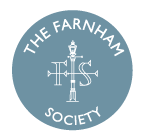Cotswold tour, 18 – 20 September 2014
Last September a 40-strong party toured the Cotswolds, with two nights spent in Cheltenham (at a hotel next to GCHQ who no doubt kept a watchful eye and ear on us!) First stop was the Arts & Crafts gem of Rodmarton Manor, near Cirencester. Built in traditional Cotswold materials in the early 20th century for Claud and Margaret Biddulph, the family have lived there ever since. Furniture, internal fittings and wall hangings were hand-made specially for the house in true Arts and Crafts style. The gardens retain their original design, comprising a series of outdoor ‘rooms’.

rodmarton lead pipe feature
Next day, on to beautiful Stanway House. The present building dates from the 16th century, but, prior to the dissolution of the monasteries, Stanway Manor had belonged to Tewkesbury Abbey since Saxon times. The Manor had several mills, and there is a mill on the site today, which has been restored recently and which we saw in operation. A 14th century tithe barn is evidence of the long history of the house. We were also treated to a display of the fountain in operation, this being the highest gravity fed fountain in the world.

Stanway House
Our final destination was Upton House, near Banbury. Built in the late 17th century, the house was acquired by Lord Bearsted (of the Shell Oil dynasty) in the 1920s, and was remodelled to add some Art Deco features inside. The house contains a superb collection of fine art and porcelain, and was hosting a temporary exhibition on Shell and the art of advertising. Outside, the garden was redesigned under Lady Bearsted’s supervision , to recreate an 18th century garden. Beyond the formal lawn and a ha-ha, is an impressive series of terraces, invisible from the house, with extensive flower beds and a kitchen garden.
A guided tour of Cotswold villages on the second day had brought J B Priestley’s words about Cotswold stone to life: “The truth is that it has no colour that can be described. Even when the sun is obscured and the light is cold, these walls are still faintly warm and luminous, as if they knew the trick of keeping the lost sunlight of centuries glimmering about them”

